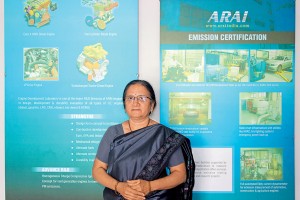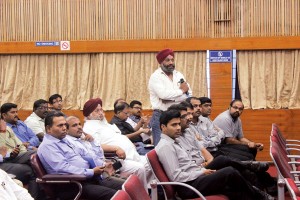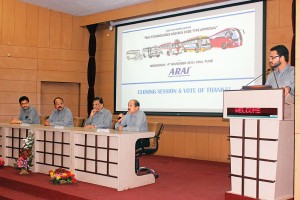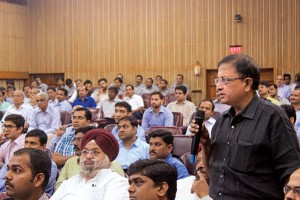Automotive Research Association Of India (ARAI) held a workshop to address the concerns of bus body builders.
Story & photos by: Ashish Bhatia
The government of India announced the implementation of the Bus Code (AIS 052) in April 2015. It came into effect from August 01, 2015. Applicable to the Indian bus industry, the Bus Code requires the bus body builders to comply with parameters like the floor levels, gangways, dimension of foot steps, seats, seating layout, hand rails and hand holds, lighting and illumination, driver’s work place, driver’s field of vision, designs of emergency exits, fire safety, window frames and their placement, dimensions of overhead luggage racks, head lamp beam levelling, mirrors, safety pictogram, and a host of other facets concerning the exterior body projections and interior fittings. Stressing on ensuring adequate provisions for the disabled passengers, the Bus Code makes the age-old luggage carriers on the roof a thing of the past. The code also stresses on ensuring stability and strength of the bus body structure, seat anchorages and a roll over analysis for the full body to minimise the impact if the bus were to turn turtle. Compliance with such stringent parameters is likely to put the unorganised part of the Indian bus industry, which accounts for 70 to 80 per cent, at the risk of losing business.
To ensure that the unorganised part of the Indian bus industry does not risk going out of business, the Automotive Research Association Of India (ARAI), organised a workshop recently. First of its kind to be organised by ARAI regarding the Bus Code, over 150 people participated. Speaking about the need for such an event, Rashmi Urdhwareshe, Director, ARAI, expressed, “We felt that there was a need for dialogue; to understand and fill in the gaps if there were any. There was a lack of approach for approval despite the notification of Bus Code in April 2015. We have the technical expertise, and people could come and seek it.” Asked a bus body builder about sleeper coaches, that they are unable to get clearance from the state authorities. AA Badusha, Deputy Director, HMR, ARAI, replied that his organisation would be able to provide clarity on sleeper coaches after a period of three to six months. “A revision of AIS 052 (Bus Code) or a completely different code is likely to be introduced for sleeper coaches after weighing the pros and cons,” he added. Another coach builder touched upon double deckers. Badusha responded that double deckers would also get due attention.
Questions asked by Mandeep Singh, Technical Head, Ronak Engineers and Consultants, spanned from a critical component like battery not under the purview of the Bus Code, to how the authorities planned to address the shortcomings in the Compliance of Production (COP), which would ensure manufacturers mass produce in accordance with the approved prototype. ARAI officials said that they would take it up with the Ministry of Road Transport and Highways (MoRTH). Devilal Suthar of Janta Motor Body, Bhilvada, voiced his concern about having his ready to deliver buses comply with the Bus Code. There were many other bus body builders who shared the same concern. Explained Rashmi Urdhwareshe, that their apprehensions are justified. She drew attention to the fact that many bus body builders have started to form a cluster, optimise their resources, and link up with the OEMs. Stating that it will take time, Urdhwareshe mentioned that the Bus Code was made necessary because vested interests were stalling safety approaches. An OEM representative hinted that the in house capability for body manufacturing or outsourcing makes it easier for them to meet the new specifications. In contrast, it is difficult for the unorganised players to sustain in such an environment. Especially, when the price of accrediting a base model ranges in the region of Rs. 9 lakh and is likely to take anywhere between six to eight weeks. Exclaimed Urdhwareshe, “Bus body builders have made several representations, seeking time and seeking reduction in the cost of testing. All these factors have been considered.” She explained, that manufacturers or bus body builders with similar products will have to weigh the incremental rise in costs. Approvals for other designs, modular in nature, would be linked to the original design for cost effectiveness. For a company to develop a bus body design today, it requires CAD images and various chassis details from the respective manufacturers for them to be integrated and checked for roll-over protection. Stringent bus body regulations are set to dictate a close working relationship between OEMs and bus body builders. It could percolate down to a level where OEMs engineer a basic structural bus design and share it with the bus body builder as he buys the bus chassis from them. The other way would be to share detailed bus body building drawings that would enable the respective bus body builder to build a bus that conforms to the Bus Code.
On the sidelines of the workshop, ARAI officials conducted a demo of the Bus Code accreditation process. If this gave an opportunity to some bus body builders to have the experts check their prototypes, the officials demonstrated the use of ready templates for building the bus body. These templates were of the service door, the steps, etc. Failing to match the template (tolerance), it would be necessary to revisit the design and development process. Said Urdhwareshe, “We have the capability to assess the structural strength, noise and vibration among a host of other bus characteristics. We also have the capability to assess interior noise and test vehicle stability. The advantage of lab simulation that we are capable of conducting will help the designer to come up with an optimum design in a cost effective way. At the component level we have a huge expertise in headlamps, tail lamps and all that goes into a vehicle. We also cater to specific requirements such as testing the flammability of materials used in the bus and also the fire compatibility of fuel tanks.”
Set to have a lon g term effect on the Indian bus industry, the Bus Code will play a crucial role in the transformation and modernisation of the industry. This was aptly highlighted by the ARAI workshop.
g term effect on the Indian bus industry, the Bus Code will play a crucial role in the transformation and modernisation of the industry. This was aptly highlighted by the ARAI workshop.
Rashmi Urdhwareshe, Director, ARAI
Q. What gave boost to the Bus Code (AIS 052) under Rule 125 (c) of Central Motor Vehicle Rules (CMVR)?
A. We look at a vehicle as an integrated and complex engineering product. Constructional safety of a bus is governed by the components and sub-systems. Often the complete chassis is manufactured by a vehicle OEM, and the vehicle body is built by the body builder. Each component of the bus contributes towards safety. It is therefore necessary that the component manufacturers, designers and OEMs own the responsibility. It is very important that the regulation clearly identifies who’s role is what (in the manufacture of a bus), and that has been the triggering point. What gave a boost (to the Bus Code) is an effort to clearly identify the responsibilities in such a way that constructional safety of buses is clearly documented, tested, verified and certified.
Q. What role will ARAI carry out in the implementation of the Bus Code?
A. There are multiple roles that the ARAI will play. This would include the provision of guiding the manufacturers; providing correct interpretation of the technical requirements, carrying out all the mandatory tests, issuing type approval certificates and so on. ARAI specialises not just in carrying out ‘Type Approval’ testing but also provides development tools, simulation and validation services, and technical expertise to help manufacturers prepare for compliance. With the introduction of any new rule or technical standard, it is expected that the existing vehicle/system design undergoes changes. In addition, manufacturers also have to focus on specific customer requirements, such as UBS (Urban Bus Specifications). Regulations provide minimum common platform and finally it is the consumer who controls the performance and other requirements, which often are beyond regulations. In order to ensure that the product complies, ARAI will also carry out a technical evaluation as per specific tender requirements and submit a report on it to the government authorities. We also provide end-to-end solutions to the customers for designing of their products. All our labs are equipped to cover all the above requirements. Our role is such that we fit into each and every part of the overall process of bus construction and approval.
Q. How well is ARAI equipped to handle such an exercise?
A. ARAI is well equipped with 12 different laboratories. Each laboratory is dedicated to a particular subject such as structural dynamics, automotive electronics, powertrain engineering, automotive materials, noise vibration and harshness, emission certification, vehicle evaluation, active and passive safety, etc. We have full capability as well as the capacity to carry out testing and evaluation of various aspects such as structural strength, roll over protection, noise, vibration and other characteristics of buses, seats, anchorages, mirrors, horns, tyres, under-run protection devices and several other mandatory tests. We also have the expertise to evaluate and improve interior noise, construction of windows and doors, emergency exits, fire safety and flammability, Its features and so on. In addition to physical testing, ARAI has developed expertise in simulation tools which are very much essential in minimising the testing and development efforts as well as save on the time taken. Simulation testing for bus roll-over requires considerable expertise and we have a dedicated team to take up the projects. Demonstrating good co-relation of laboratory simulation with physical testing, which helps the designer to come up with an optimum design in a cost effective way, apart from saving time and testing efforts, it also gives a lot of standardisation opportunities in vehicle design. At the component level we cover the entire spectrum of safety components that go into a vehicle. To safeguard against fire hazards, there are specific requirements like flammability of the interior materials, fire compatibility of fuel tanks and effectiveness of evacuation through escape windows. Our testing capabilities are also supported by the design and revalidation expertise.
Q. How much time will it take to get ARAI Bus Code certification?
A. It would depend on the scope of his (bus body builder’s) work. It is not the first time that a regulation has been introduced for buses. All the commercial vehicles have been subjected to tests and approvals in the past. At the chassis level as well as at the complete vehicle level, there have been mandatory test standards and regulations. Vehicle models are already in compliance with BS IV or BS III (as the case may be) emission norms. The ABS requirement has already been notified. With AIS 052, the specific requirements related to bus construction are now notified. So it is not expected that the testing and approval will start from scratch. Manufacturers use already approved components and type approved bus chassis. They do the body building of the vehicles and the final product has to comply on an individual component or system level as well as at the complete vehicle level. To answer your question about the time required, I would say that it is difficult for us as a test agency to estimate. It would rather depend on the readiness of the manufacturer. To give you a rough idea, the bus roll-over (physically or through simulation) and verification of bus construction, could be completed in four-to-six weeks. We have multiple labs, where parallel activities related to component approval, emission testing etc. can be carried out. It depends on how prepared the manufacturer is. How technically ready he is.
Q. What could be the costs incurred in the certification process?
A. Typically it is of the order of Rs. 9 lakh per model. It is the base cost covering mandatory tests on the vehicle. In the event that a manufacturer or a body builder has similar such products, ARAI suggests worst case criteria, which reduces the cost for subsequent models or variants having similar specifications. For designs that are modular in nature, once a system is established, further approvals can be linked with the original type approval.
Q. What has the dialogue with the bus industry highlighted?
A. Bus construction related requirements have come into existence in two stages. First step was accreditation. It was aimed towards assessing the capability of the body builder in the designing and building of complex products. That was introduced much earlier, and in the last three to four years it has enabled them to organise their operations for better product design. Test agencies like ARAI are authorised for granting this accreditation. The second step was to introduce a technical requirement, a comprehensive code in the form of AIS 052 standard. The intention of that standard was to grant type approval for fully built buses. Buses are being registered even today, but it is the second stage approval that is being done by the State Transport Authorities (STAs). Since these authorities do not have requisite test facilities and expertise to test and certify the provisions of AIS 052, it will now be the responsibility of the test agencies under CMV Rule 126 to test and approve the prototypes submitted by bus body builders. With these approvals, the body builder would be able to register his vehicle in various states.
Q. So, is the new certification process about prototype level compliance rather than the compliance at the fully built level?
A. As stated above, the STAs do not have the technical expertise as well as the resources to verify AIS 052 compliance, which is not just a physical verification but also involves extensive tests. As a result, the new certification process calls for a prototype level compliance for fully built buses. This should explain why the certification process has been brought under type approval while the rest of the registration process will continue as it is.
Q. Have the European bus regulations influenced the Indian Bus Code?
A. When we started the exercise of developing AIS 052 standard about 10 years ago, we based these requirements on already existing technical regulations in Europe. By the time our standard was established and is being implemented now, the base regulation in Europe has moved forward considerably. New requirements related to fire safety and frontal crash have been introduced. We are tracking those developments. We are also aware of our own requirements. Bus Code has it all integrated, and prescribes minimum safety requirements that we should start with. Our objective is to benchmark ourselves to international designs in the near future. The government desires that the industry should be actively involved so that this migration takes place at a steady pace. Our objective is to achieve better road safety.
Q. Why did it take this long for the Bus Code to be implemented?
A. In my opinion we are not a safety conscious country. We wait for regulations to mandate safety. It is often seen that the consumer is very sensitive to aspects like cost, fuel consumption and maintainability of the vehicles. Very little attention is however paid to the vehicular safety as well as road safety. With the increasing rate of accidents, we cannot wait for the consumer to get educated and demand safety. A decision was therefore made by CMVR-Technical Standing Committee in consultation with stakeholders to bring about the regulation and ensure that everybody follows it as a basic requirement. It gives all the designers a common ground to work upon. The same approach was followed earlier for evolving standards for other auto segments like passenger vehicles. Despite keeping an open view about the global products, due consideration has been given to our indigenous designs. Our satisfaction stems from the fact that at least the OEMs are forthcoming in ensuring Bus Code compliance. We have also appealed and advised them to standardise their designs and hand over these designs to the body builders, so that the quality of the product is ensured. Finally the vehicle that runs on the road carries the OEM’s name and rightfully its the OEMs who take the product liability. Our advice to OEMs therefore is that they could develop and own the designs but let the body builders use these standardised designs with due authorisation so that a cost effective and efficient ecosystem develops.
Q. Are you saying that OEMs could go the Tesla Motors way, which open sourced their patents resulting in the acceptance of electric passenger vehicles?
A. That’s a possibility. Bus body builders with their vast experience have also matured over time. By no means should we belittle their wisdom and technical expertise. What is lacking is an integrated approach towards vehicle design and product liability. This sector was encouraged in order to promote and support small scale manufacturing. Even when the truck code was developed, it was seen that despite having the manufacturing ability and capacity, OEMs outsourced work to another sector for cost effectiveness.
Q. How do you think the Bus Code will impact the industry? The unorganised sector?
A. There is a need for good designers who can standardise products or can undertake a modular approach the way it is elsewhere in the world. There will thus be no need to reinvent the whole design. The body builder can improvise, can offer value added designs by letting the core construction remain the same. The apprehensions of body builders were addressed by the Ministry. Many body builders now have started to form a cluster to optimise their resources and link up with the OEMs to adapt good design practices. Overall the direction is good, but it will take time before we start getting the desired results. Because of individual interests, things may not work as swiftly. It was also the reason why the need for body builder accreditation was initially felt. Those who demonstrate capabilities would receive accreditation. Those who do not, will have to migrate to achieve it.
Q. Body builders seem concerned about the need to travel all the way to ARAI at Pune?
A. The vehicle is required to be brought to the test laboratory since certain physical tests such as the roll-over test, anchorage test, etc. cannot be done at the manufacturer’s. And, this is the case with other sectors too. In order to facilitate approval process, we do carry out some of the tests at the manufacturer’s site, where ever it is possible to transport the test facilities to such sites. We will obviously look at minimising the efforts, time and logistics involved in transporting such vehicles.






















